29 Types Of Florida GULF COAST BIRDS (ID Guide With Photos)
Did you recently spot a bird at the Florida Gulf Coast? In that case you’ll probably want to know what species you saw.
Identifying the birds of the Florida Gulf Coast is not an easy matter, since there are many different types of birds that frequent the beaches and seaboards of the Florida Gulf Coast.
To help you identify the bird you saw, we’ll cover the most common birds of the Florida Gulf Coast in this article.
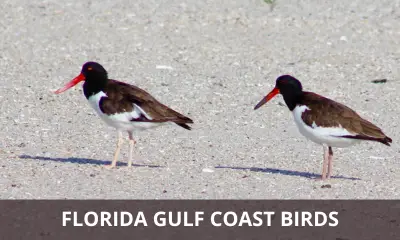
What are the types of Florida Gulf Coast birds?
There are 29 types of birds commonly found along the Florida Gulf Coast, which are described in full detail below.
Double-crested Cormorant
Scientific name: Phalacrocorax auritus
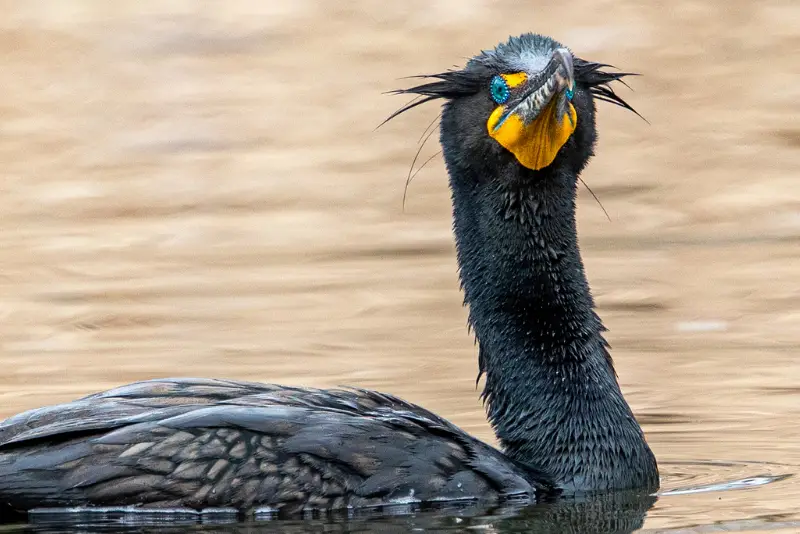
The Double-crested Cormorant is a large, dark waterbird with a long neck and blue eyes. It is a year-round resident in Florida, and is commonly found along the Gulf Coast.
This cormorant likes to gather in large flocks that roost on trees close to water. It is a common diving bird and hunts fish with its large, hooked bill.
When a group of cormorants flies together, they like to form up in a V shaped formation.
Often these V-shaped formations can be seen in the evening, when the birds fly to their roosting spots.
Anhinga
Scientific name: Anhinga anhinga
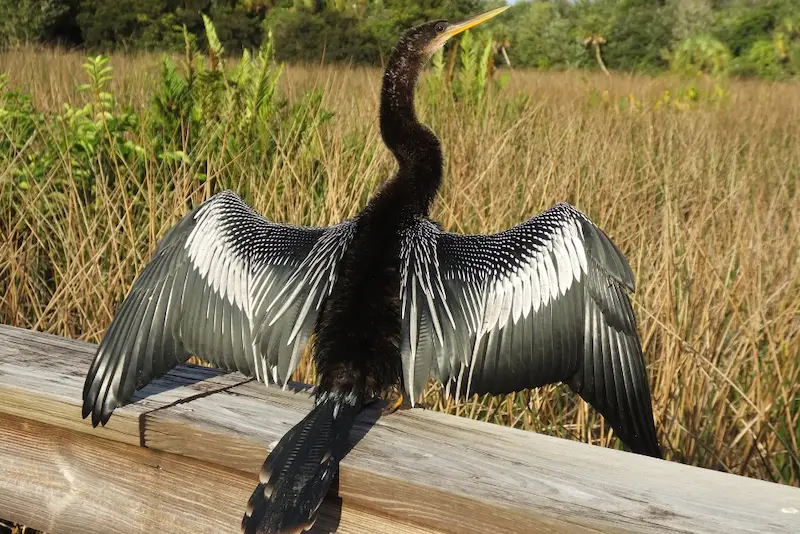
The Anhinga looks similar to a cormorant, but has a snake-like neck, which it uses to catch fish underwater.
When it is in the water, it’s common to see only the head and neck protruding above the water surface.
Adult male Anhingas are almost entirely black, while females have a dark brown head and neck, as well as black body plumage.
It lives in swamps and freshwater ponds, and is a year-round resident in Florida.
Brown Pelican
Scientific name: Pelecanus occidentalis

The Brown Pelican is a common sight along the Florida seashore, where it hunts fish by plunging head-first into the water.
Adult Brown Pelicans are grayish brown with a dark belly, and can be easily recognized by their massive bill.
While this pelican species was endangered a few decades ago due to pesticide poisoning, it has now recovered and is once more a common breeding bird and year-round resident in the state.
American White Pelican
Scientific name: Pelecanus erythrorhynchos
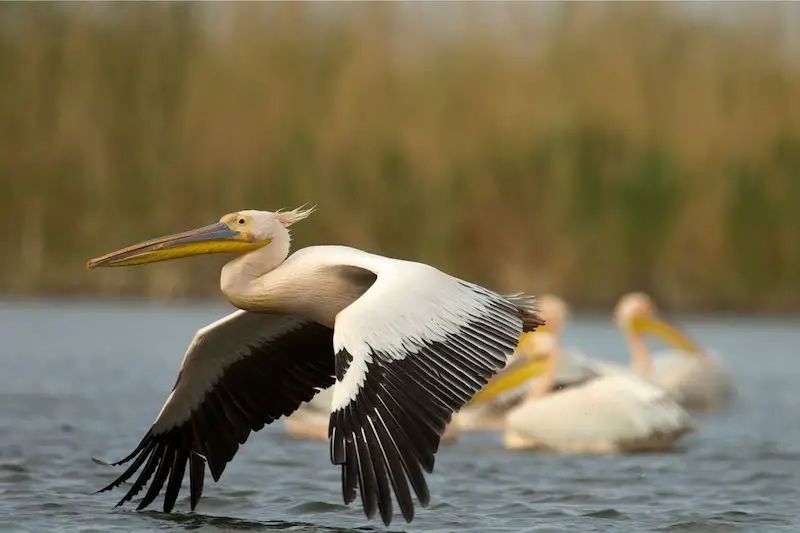
The American White Pelican is one of the largest aquatic birds in North America, and is almost entirely white, except for black primary and secondary feathers on its wings.
Its huge beak is bright orange, and has a flat plate protruding from the upper part of the beak during the summer breeding season.
Outside of the breeding season, the long bill changes its color from orange to pale yellowish.
These white water birds with long beaks breed in the northern US, and spend the winter along the Gulf Coast, as well as in Florida and California.
With a wingspan of up to 10 feet, and a body weight of up to 30 pounds in males, the American White Pelican is one of the biggest birds in Florida.
Its preferred habitat are estuaries, shallow bays, and coastal inlets, as well as freshwater lakes further inland.
American White Pelicans are most often seen in groups that like to cooperate with each other when foraging for fish.
Sanderling
Scientific name: Calidris alba
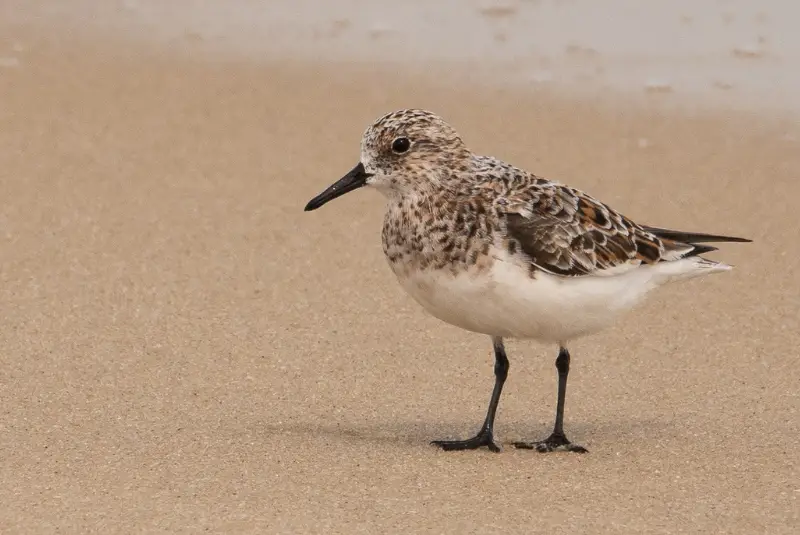
The Sanderling is one of the most common shorebirds in Florida during the cold months, where it can be seen wintering from late August to April.
During the winter the plumage of Sanderlings is mostly white, and at this time of the year it is the lightest small wading bird on the beach.
The white stripe on its wings is only seen when it takes to the air.
Sanderlings like to forage in small groups on beaches, and run along the beach with surprising speed. They feed on small animals that are exposed by the breaking waves.
Another great characteristic for identification of Sanderlings are the white wing stripes, which flash brightly when it flies.
Short-billed Dowitcher
Scientific name: Limnodromus griseus
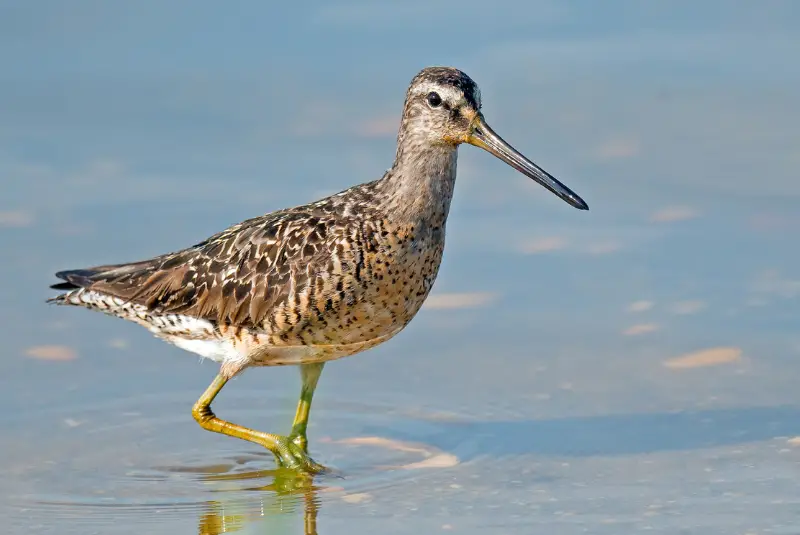
The Short-billed Dowitcher is a medium sized wading bird that is relatively easy to identify by its long, straight, dark bill.
It is a common year-round resident along the Florida Gulf Coast, but is also found in freshwater habitats.
During the winter it has a brownish-gray upperside, and white underside. During the breeding season, the throat and chest turn cinnamon orange.
This shorebird uses its long bill to probe for small invertebrates in muddy and sandy areas.
Black-necked Stilt
Scientific name: Himantopus mexicanus

This wading bird is easy to identify by its striking black-and-white plumage coupled with long reddish pink legs.
With legs that are more than 9 inches long, the Black-necked Stilt has the longest legs of any bird in proportion to its body size.
This striking Florida beach bird is a year-round resident in the state. Its preferred breeding habitat are shallow marshes, but during the winter it is also found along the Gulf Coast.
Spotted Sandpiper
Scientific name: Actitis macularius
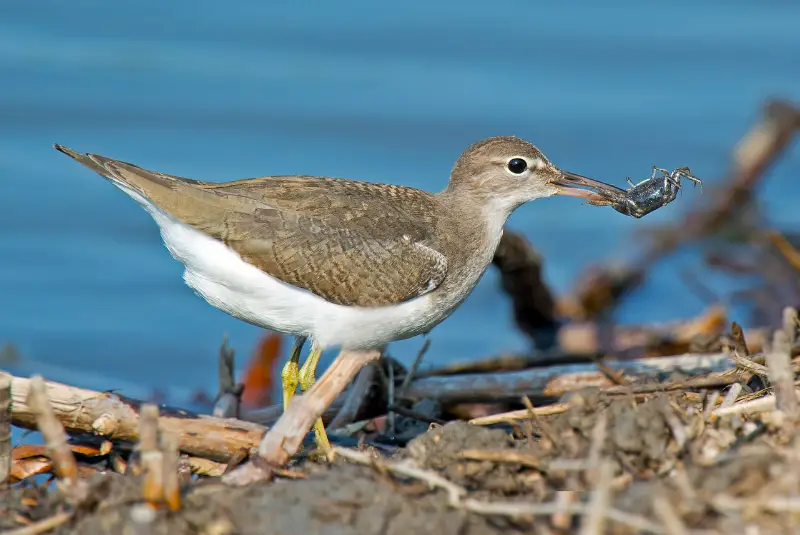
The Spotted Sandpiper is a common sandpiper in Florida, where it can be found on the edges of creeks and estuaries, as well as in freshwater habitats.
During the winter this water bird has a brownish gray upperside, which contrasts with its bright white underside. A great way to identify it is by its constant bobbing of the tail.
It forages on banksides and muddy areas, where it picks up small insects and invertebrates from the ground.
Willet
Scientific name: Tringa semipalmata
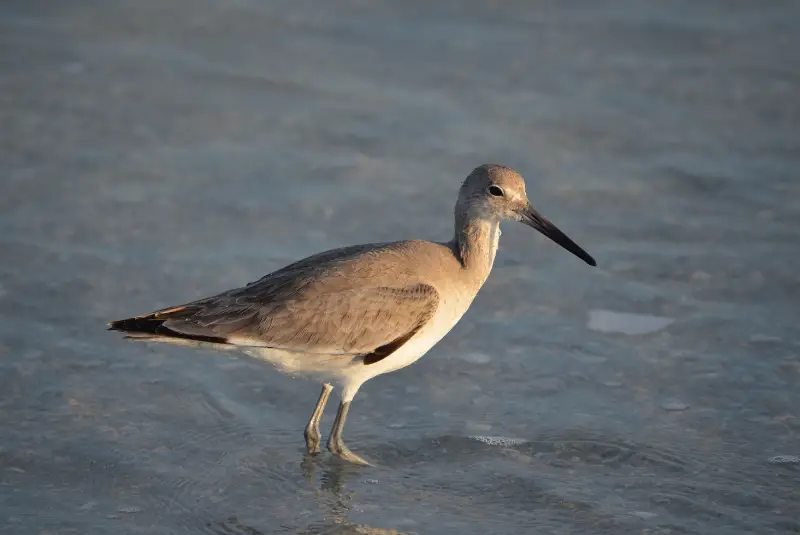
The Willet is common along the Gulf Coast of Florida during the winter, but is also a year-round breeding bird in northern areas of the state.
It is a medium sized wading bird with a brown upper side and a white underside. It is a beach bird that only occurs in saltwater habitats.
When it takes to the wing, its conspicuous black and white wing markings become visible. It forages for small insects, worms, crabs, and other invertebrates along the ocean shore.
Black-bellied Plover
Scientific name: Pluvialis squatarola
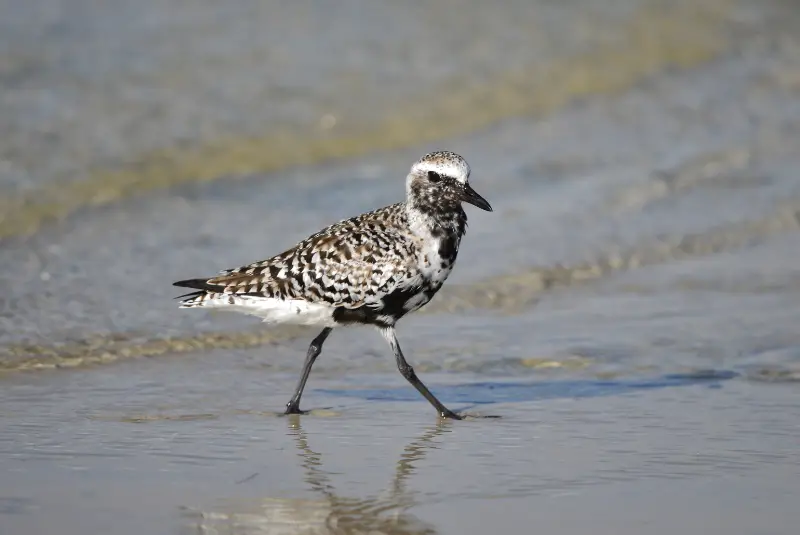
During the breeding season, the Black-bellied Plover is easy to identify by its striking black belly, breast, flanks, and face.
Outside of the breeding season, it is more drab, with white underparts and brown upperparts, and resembles a Sanderling in coloration.
However, it can be easily distinguished from a Sanderling by its much larger size.
This seabird is a winter visitor to Florida beaches, where it can be seen from late July until April.
Snowy Plover
Scientific name: Charadrius nivosus
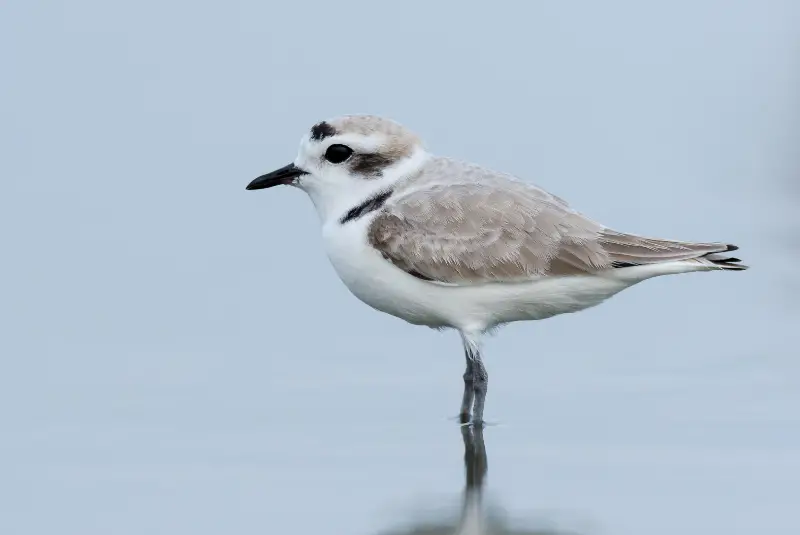
These small Florida birds are found on inland breeding sites during the summer, or wintering along the Gulf Coast during winter.
Snowy Plovers tend to forage higher up on the beach than other shorebirds, and due to their diminutive size are easy to overlook.
In their winter plumage Snowy Plovers are largely light gray on top, and bright white on the bottom, with a white collar and hint of a darker collar next to it.
Wilson’s Plover
Scientific name: Charadrius wilsonia
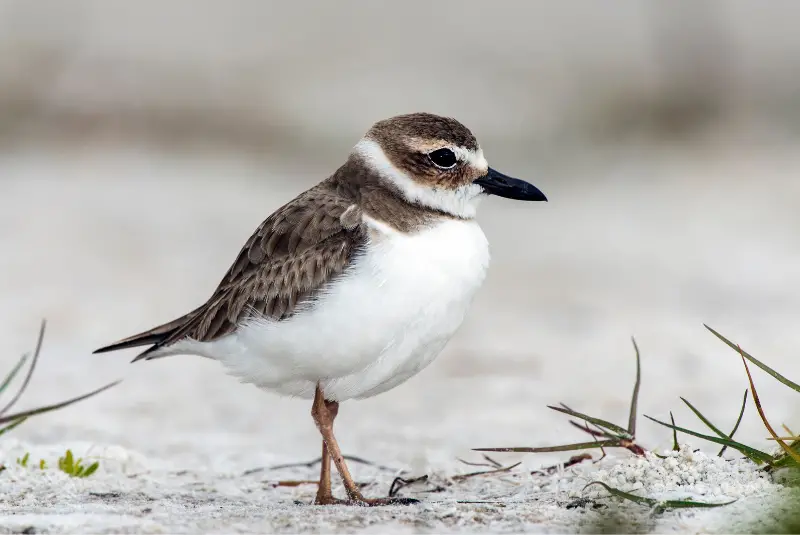
Wilson’s Plovers are uncommon breeding birds along the Florida Gulf Coast, and are year-round residents in southern parts of the state.
These plovers are specialized on hunting fiddler crabs, which they do high on the beach, where they can be hard to spot.
Wilson’t Plovers are brownish gray on top, and have a broad white collar and a white eyebrow stripe and forehead.
Piping Plover
Scientific name: Charadrius melodus
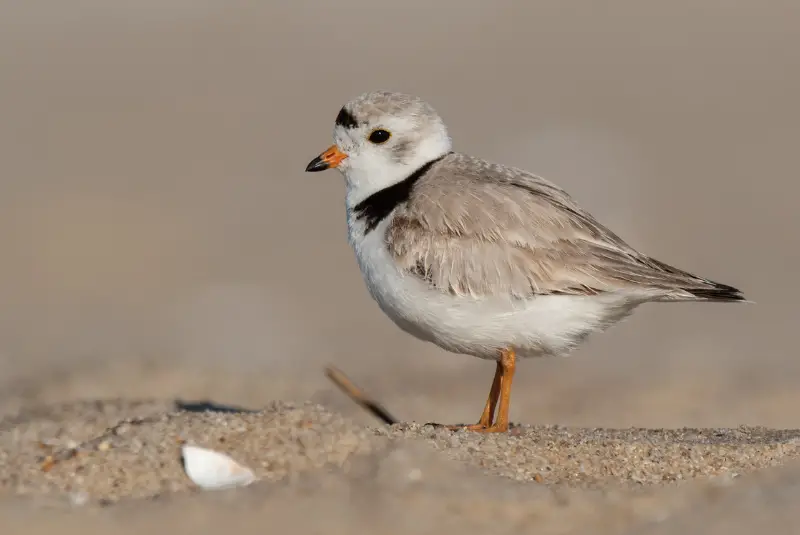
Similar to other plovers, Piping Plovers blend in extremely well with their surroundings, and thus can be difficult to spot unless you see them scurrying from one spot to another.
Their breeding grounds are in the northern midwest, while they spend the winter along the Gulf Coast, as well as the Atlantic Coast of Florida.
Their backs and heads are light gray with a white collar dividing the two, while the underside is pure white.
Killdeer
Scientific name: Charadrius vociferus
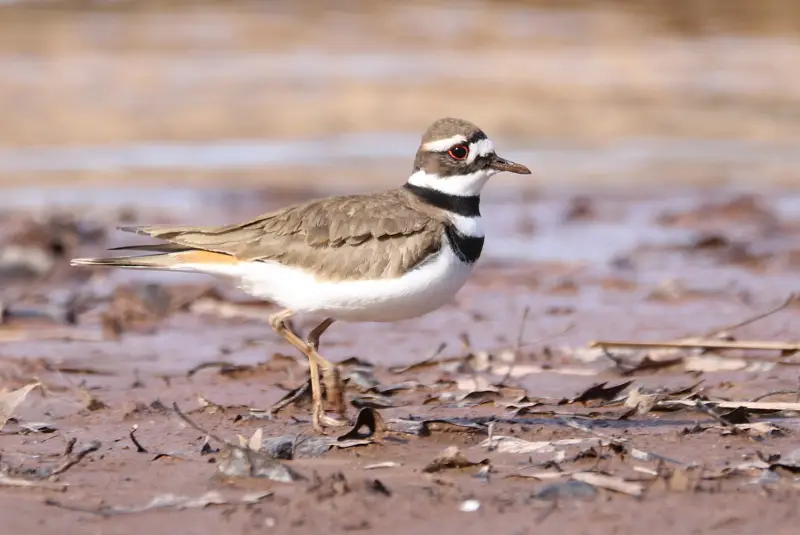
While Killdeer are also shorebirds, they are often encountered in man made habitats as well, including golf courses, playing fields, and parks.
Their coloration seems almost colorful compared to other plovers, with warm notes of rusty brown, black, and white mixed in with each other.
These birds are common breeding birds throughout Florida, and can be seen anywhere there are wide open lawns.
American Oystercatcher
Scientific name: Haematopus palliatus
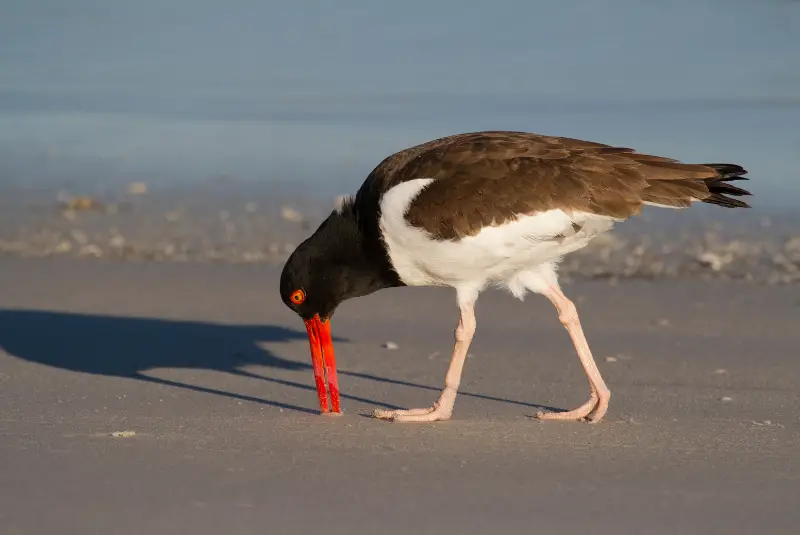
American Oystercatchers are beautiful beach birds with striking coloration. They have a jet black head and neck, which contrasts with a bright white belly and a long, heavy red bill.
The Oystercatcher is a bird of the tidal flats, where it follows the tidal patterns to feed on shellfish during low tide.
The heavy bill of the Oystercatcher helps it to pry open the shells of mollusks, and it also serves for hammering their shell until it shatters.
It is a year-round resident along the entire Florida Gulf Coast, inhabiting the tidal flats and beaches.
Great Egret
Scientific name: Ardea alba
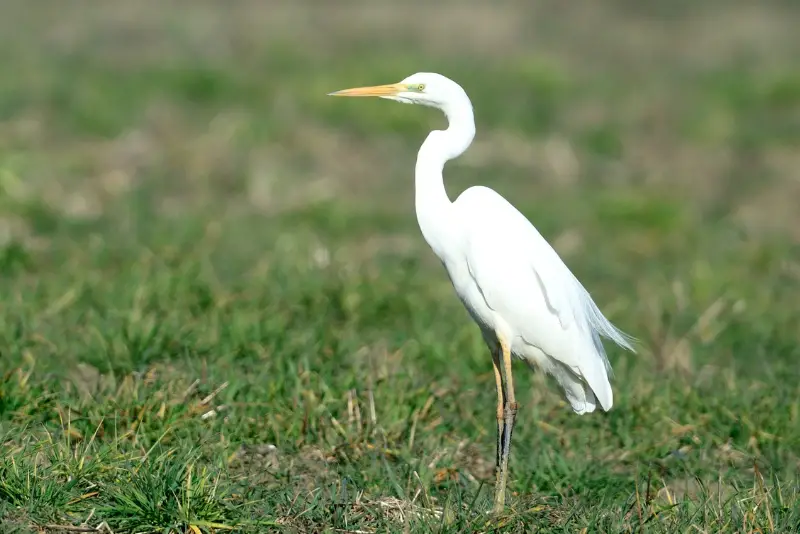
The Great Egret has a range that spans nearly the whole planet, and can be found on almost all continents.
This heron is a big bird that is all white, and it has long black legs and feet along with a thick, yellow bill.
During the spring and summer breeding seasons, the Great Egret grows a plume on its back that extends all the way to the tip of its tail.
It lives in both saltwater and freshwater habitats, and often nests in large colonies on the banks of marshes, lakes, and rivers.
Great Egrets forage in any type of shallow water, including ponds, lakes, rivers, estuaries, as well as rice fields and other flooded areas.
It is especially prevalent in the eastern and central regions of the state throughout the summer.
Outside of the breeding season it is less common, but where it occurs it can be seen in large flocks.
Snowy Egret
Scientific name: Egretta thula
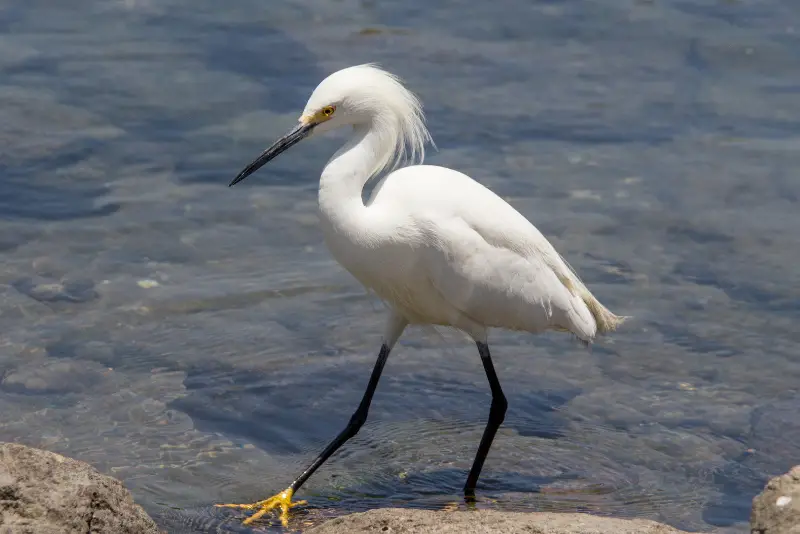
The Snowy Egret has become an increasingly common breeding bird all over Florida.
This is due to aggressive conservation efforts that were necessary because this Egret species was systematically hunted in previous centuries.
This little white heron stands out due to its slim black bill and bright area between the eyes and nostrils. It has long legs and yellow feet, which distinguish it from other herons found in Florida.
In adult birds, the feet are a brilliant golden yellow, while the legs are totally black. It is thought that the brightly colored feet help to attract small fish and other prey.
The legs of juvenile birds have a predominant greenish yellow color, with some black areas on the front of the leg.
It is found in practically all types of wetland environments, from small ponds to saltwater and everything in between.
During the summer, the Snowy Egret is a rare to relatively common breeding bird in the state.
It is much more common during the winter months, when large numbers can be observed along the Florida Gulf Coast.
Reddish Egret
Scientific name: Egretta rufescens
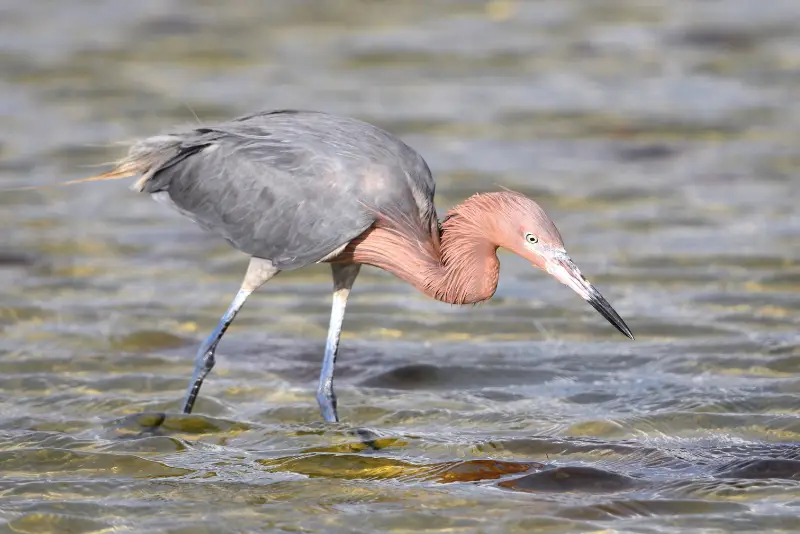
The Reddish Egret is a bird of shallow saltwater habitats in coastal areas of the Florida Gulf Coast, and the Florida Keys, where they are year-round residents.
These herons have an unusual foraging tactic when compared to other herons. They hunt for small fish on salt flats at low tide.
But instead of patiently waiting for fish to come within striking distance, Reddish Egrets pursue their prey by rapidly wading through shallow water, while waving their wings to startle small animals.
These small herons have a dark morph and a white morph. The best way to identify them is by their bi-colored bill, which is yellow at the base, and black at the tip.
Great Blue Heron
Scientific name: Ardea herodias
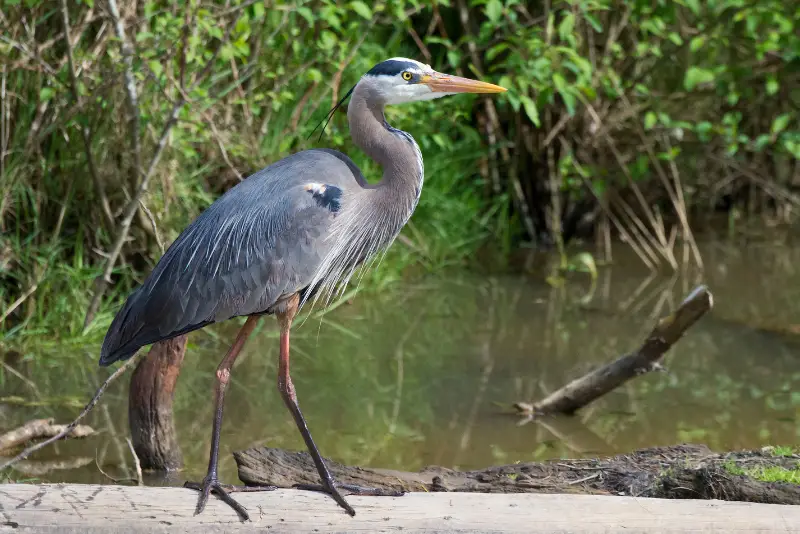
The Great Blue Heron is one of the most common herons in Florida, where it can be seen year round.
This heron is a very large bird with a wingspan of up to 6 feet. It is almost entirely blue gray, except for a white throat and eye stripe, as well as dark gray wing feathers.
This large heron likes to hunt for small fish by wading in the shallows of estuaries, mud flats and marshes along the seaboard.
It waits patiently for a suitably sized fish to come close enough to be grabbed with its long, yellow bill.
White Ibis
Scientific name: Eudocimus albus
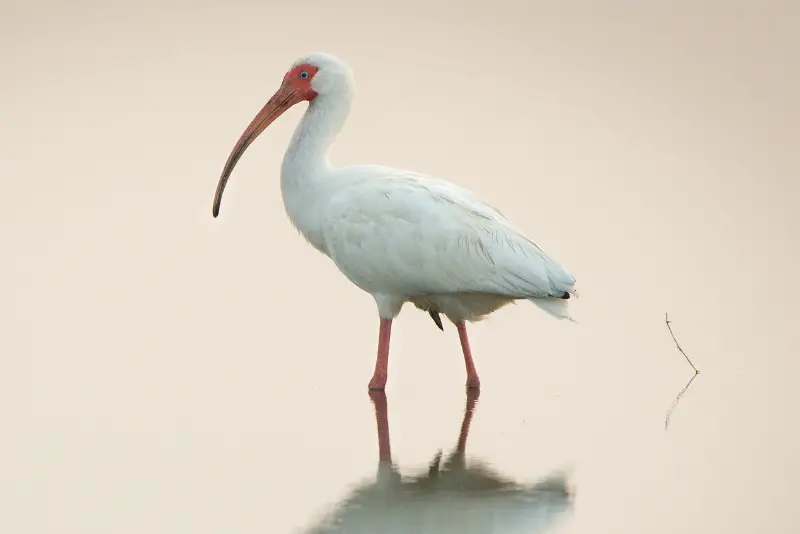
This species is easy to recognize due to its entirely white plumage and long orange beak that is curved downwards.
The black wing tips are not really apparent until it takes to the wing.
During the first two years of their lives, immature White Ibises have a chocolate brown body with light streaks and a pale orange beak.
While it is commonly found along the Gulf Coast, the White Ibis prefers to forage in freshwater habitats that are near the shore.
This shorebird feeds on fish, insects, crayfish, and other crustaceans. Crayfish form a large part of its diet in areas where they are common.
Glossy Ibis
Scientific name: Plegadis falcinellus
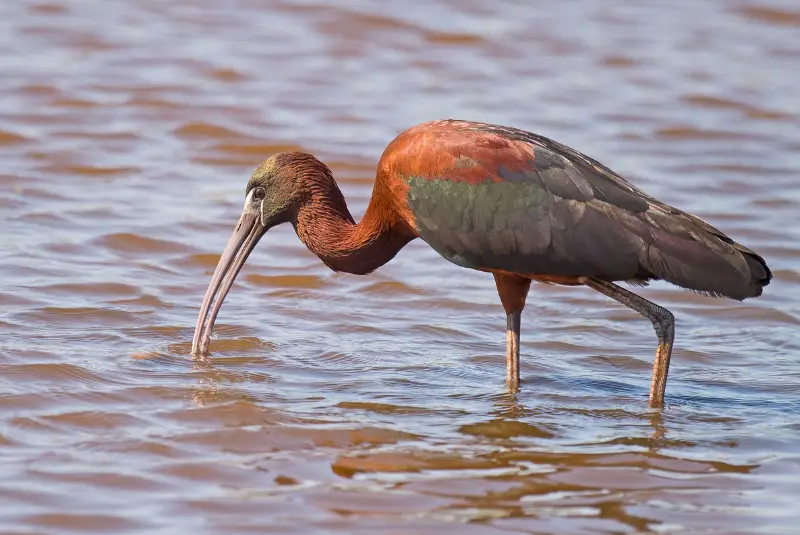
The Glossy Ibis is much darker than the aforementioned White Ibis, and viewed at a distance it looks uniformly dark brown.
But if you get a chance to view it up close in good light, you’ll notice that its plumage has glossy shimmers in many different colors, ranging from purple to green and violet.
The Glossy Ibis frequents freshwater habitats such marshes and shallow lakes, as well as saltwater lagoons and mangrove forests.
It is a regular breeding bird and year-round resident throughout Florida.
Osprey
Scientific name: Pandion haliaetus

While the Osprey is technically not an eagle, it has a wingspan of up to 69 in (5.5 ft), and resembles an eagle in size.
It is usually easy to identify the Osprey due white belly and chest, which contrast with its blackish gray upperparts and black wrist patches on its lower wings.
This large Florida bird of prey is the only raptor species that plunges into water in order to catch fish, often becoming entirely submerged in the water as it attempts to grab a fish with its feet.
Due to this style of hunting, Ospreys are almost always found close to water, except during migration, when they will cross areas without water.
The Osprey is a regular though not very common breeding bird throughout the state of Florida.
Laughing Gull
Scientific name: Leucophaeus atricilla
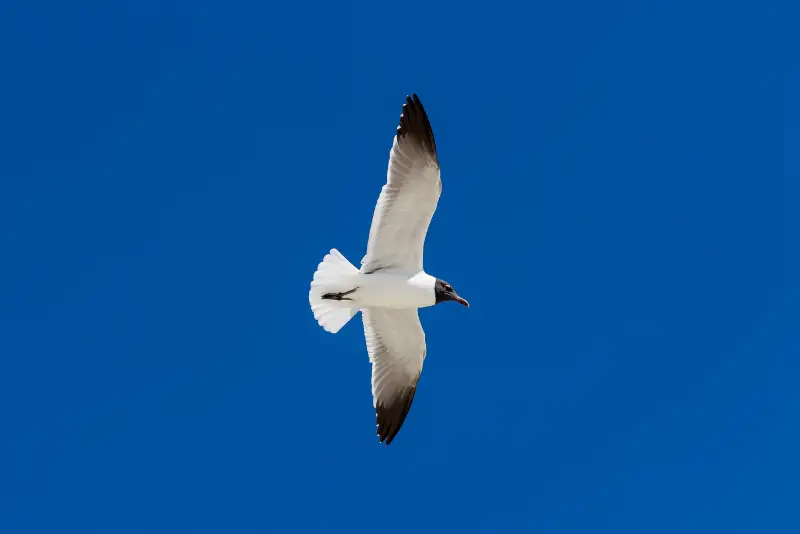
The Laughing Gull is common along the entire Gulf Coast of Florida, and can be easily identified by its black head and its loud call that resembles human laughter.
Adult Laughing Gulls in summer are largely white, with a black head and gray upperside. Both the bill and the legs are dark red. In contrast to adults, juvenile birds are pale gray brown.
Laughing Gulls are most common close to mud flats and sandy beaches, but these birds also occur away from land, foraging over open water. These common seagulls that live in Florida year-round.
Ring-billed Gull
Scientific name: Larus delawarensis
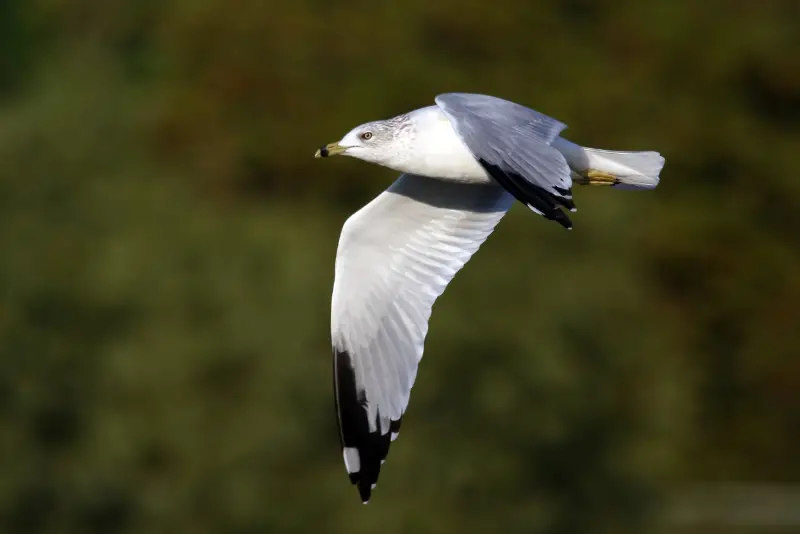
The Ring-billed gull is a common winter visitor throughout Florida. While it doesn’t nest in the state, a few birds can be seen during summer as well.
Adults are almost entirely white, except for their light gray upperparts and black wing tip, and bright yellow bill. Juvenile birds are more mottled in appearance, with a mix of brown and gray.
This seabird can be confused with the Herring Gull, but the latter is relatively rare in the state, while the Ring-billed Gull is common on large lakes and reservoirs.
The preferred habitat of this gull is close to inland bodies of water, although it also forages on parks, landfills, and golf courses. It is the most common seagull species seen at large reservoirs.
These seagulls are common birds of Florida during the winter, and start arriving in September, and most of them leave by March.
Roseate Spoonbill
Scientific name: Platalea Ajaja
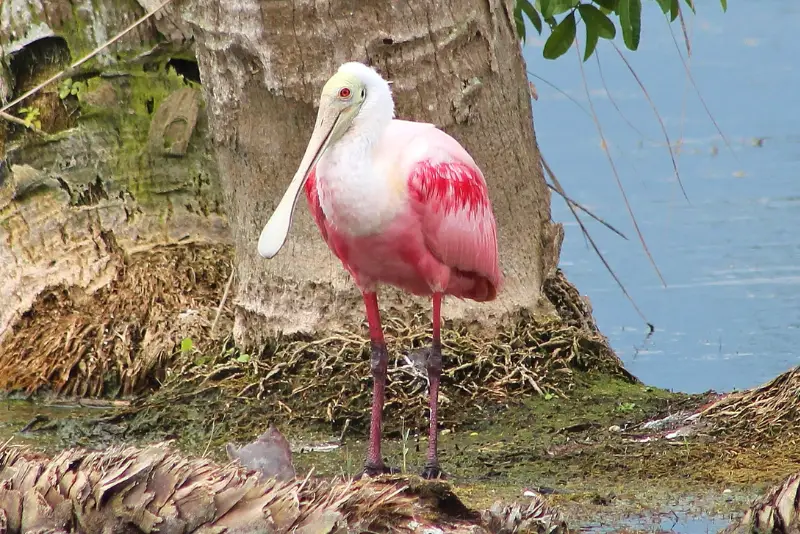
Roseate spoonbills are medium-sized wading birds, similar to storks but smaller.
The adults are white on their backs, neck, and face, while the rest of their plumage is bright pink. The Roseate Spoonbill is the most common pink-colored bird in Florida.
However, it should be noted that the exact shade of pink can vary a lot, depending on its diet.
The more shrimp it eats, the more pink its plumage becomes, due to the carotenoid substances found in shrimp.
These birds are sometimes mistaken for flamingos because they look similar, but keen ornithologists will notice that flamingos have a short, angled bill, while spoonbills have a long, spatulate bill that has a broad “spoon” at its end.
Royal Tern
Scientific name: Sterna maxima
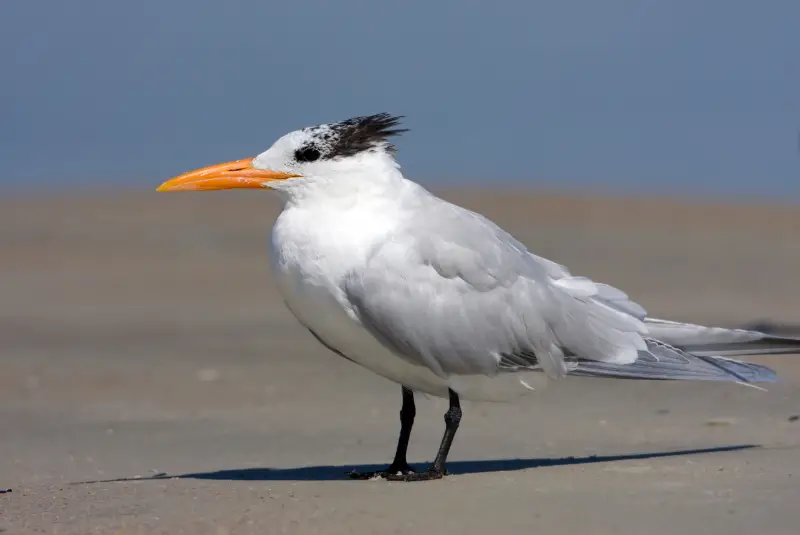
The Royal Tern is a breeding bird in southern Florida, where it can be found in Tampa Bay and Banana River.
During the winter, the Royal Tern population swells due to an influx of migratory birds that fly here from the north.
During the cold months, these beautiful birds can be seen along the entire coast of Florida. They hunt small fish by plunging head-first into the water.
Forster’s Tern
Scientific name: Sterna forsteri

The Forster’s Tern is a medium sized seabird that is a common breeding bird along the coast of Florida.
Adults are almost entirely white seabirds, except for their gray mantle and black cap. Their orange beak has a black tip.
In its non-breeding plumage, it loses most of its black cap, but can be identified by a characteristic comma shaped black eye patch.
The main breeding habitat of this tern are shallow seaside waters, including bays, inlets, and tidal flats.
In addition, Forster’s Tern may be encountered breeding in a range of freshwater settings, most frequently at lakes and reservoirs.
Outside of the breeding season, Forster’s Terns are rare winter visitors at reservoirs all over the state.
Caspian Tern
Scientific name: Hydroprogne caspia
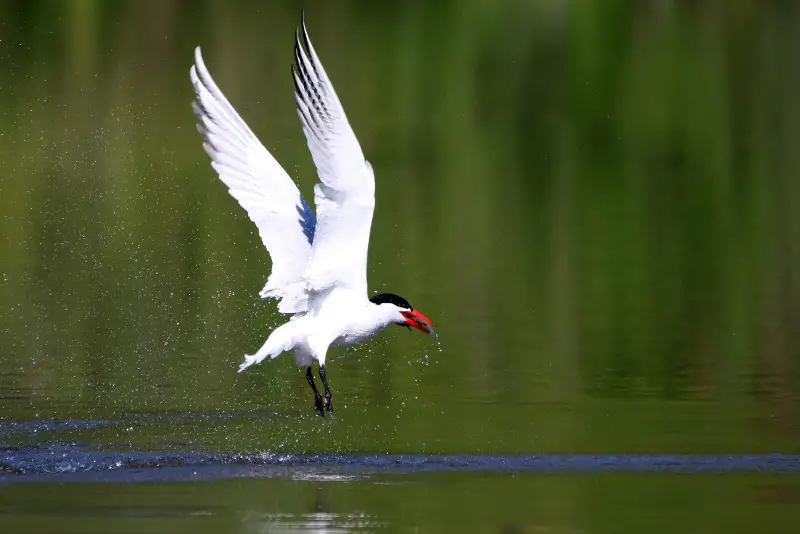
The Caspian tern is the largest tern species in the world, and a rare winter visitor in Florida.
It superficially resembles the Forster’s Tern, but it is a much larger bird and has a thicker bill, broader wings, and a less forked tail.
Also, during winter the Caspian Tern doesn’t lose its black cap completely, but always retains a streaked, dark crown.
Forster’s Terns, on the other hand, lose their cap entirely during winter, which becomes completely white.
The Caspian Tern is not only a skilled hunter, but this bird also steals food from other terns and gulls. It catches fish by diving into the water with astonishing precision.
The Caspian Tern breeds in freshwater habitats in Canada and northern USA, and winters in the Caribbean and the Gulf of Mexico.
Black Skimmer
Scientific name: Rynchops niger
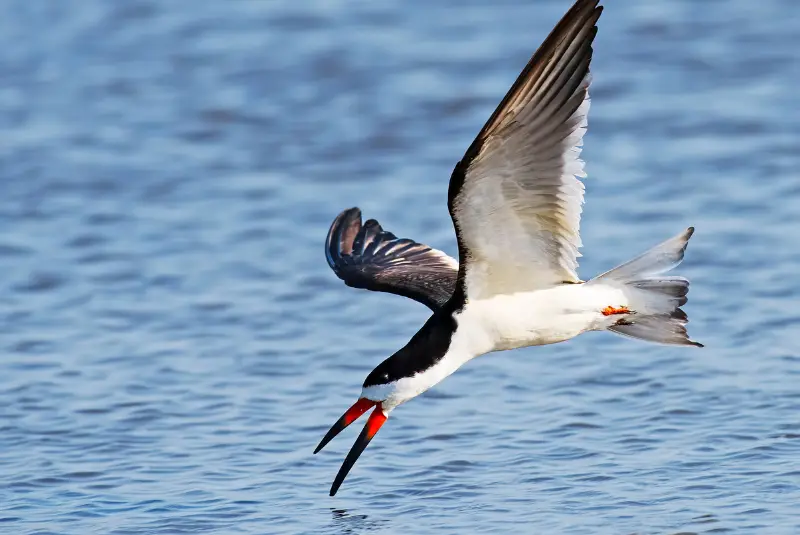
The Black Skimmer is a striking shore bird that is easy to identify both by its appearance and its behavior.
The black upperside contrasts with a bright white underside, and with a long, bright red bill. The lower part of the bill is significantly longer than the upper part.
It catches fish by flying along the water surface, while pulling its lower bill through the water. When the lower bill encounters a fish, the bill slams shut to catch its prey.
The Black Skimmer breeds along the Gulf Coast and the Florida East Coast, and also occurs as a winter visitor in more southern areas.
Final remarks
In summary, here are the 29 types of birds commonly found at the Florida Gulf Coast:
- Double-crested Cormorant
- Anhinga
- Brown Pelican
- American White Pelican
- Sanderling
- Short-billed Dowitcher
- Black-necked Stilt
- Spotted Sandpiper
- Willet
- Black-bellied Plover
- Snowy Plover
- Wilson’s Plover
- Piping Plover
- Killdeer
- American Oystercatcher
- Great Egret
- Snowy Egret
- Reddish Egret
- Great Blue Heron
- White Ibis
- Glossy Ibis
- Osprey
- Laughing Gull
- Ring-billed Gull
- Roseate Spoonbill
- Royal Tern
- Forster’s Tern
- Caspian Tern
- Black Skimmer
If you’ve spotted one of these birds, but aren’t sure which species it was, check our detailed ID guide with photos above.
If you enjoyed this article, check out our guide to the common birds of Florida.
